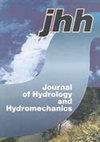How various mulch materials can affect the soil hydro-physical properties
IF 2.4
4区 环境科学与生态学
Q3 WATER RESOURCES
引用次数: 1
Abstract
Abstract An application of different mulch materials may lead to changes in soil properties. Our previous study, focused on the impact of various mulches during the 4-year period, showed that the change in some properties can be very rapid (e.g., soil pH), but in other cases such as hydraulic properties, the changes can be gradual. To find out, whether the extension of the mulching period will further affect the studied soil properties, the experiment continued for another 2 years. Differences between values of organic carbon content (Cox), soil physical quality (Sinf), gravitational water (GW) and readily available water (RAW) of soils not covered by any mulch and under various mulches (bark chips; wood chips; wheat straw; Agrotex EKO+ decomposable matting; polypropylene fabric covered bark chips; crushed stone) were much larger than those observed in our previous study. On the other hand, the opposite trend was observed for the water stable aggregates (WSA) index or soil pH. Differences between additionally measured hydraulic conductivities at the pressure head of −2 cm and repellency index (RI) were mostly insignificant. Results indicated that organic mulches can either positively (e.g., increase WSA index and Cox, and decrease GW) or negatively (e.g., decrease Sinf and RAW, and increase RI) affect soil properties.各种覆盖材料如何影响土壤的水物理特性
摘要不同覆盖材料的应用可能会导致土壤性质的变化。我们之前的研究重点是4年期间各种覆盖物的影响,研究表明,某些特性的变化可能非常迅速(例如土壤pH),但在其他情况下,如水力特性,变化可能是渐进的。为了查明覆盖期的延长是否会进一步影响所研究的土壤性质,实验又继续了两年。有机碳含量(Cox)、土壤物理质量(Sinf)、重力水(GW)和易得水(RAW)值之间的差异远大于我们之前研究中观察到的差异。另一方面,水稳性团聚体(WSA)指数或土壤pH值出现了相反的趋势。额外测量的−2 cm压头下的导水率和排斥指数(RI)之间的差异大多不显著。结果表明,有机覆盖物对土壤性质有正向影响(如增加WSA指数和Cox,降低GW),也有负向影响(如降低Sinf和RAW,增加RI)。
本文章由计算机程序翻译,如有差异,请以英文原文为准。
求助全文
约1分钟内获得全文
求助全文
来源期刊
CiteScore
4.20
自引率
5.30%
发文量
30
审稿时长
>12 weeks
期刊介绍:
JOURNAL OF HYDROLOGY AND HYDROMECHANICS is an international open access journal for the basic disciplines of water sciences. The scope of hydrology is limited to biohydrology, catchment hydrology and vadose zone hydrology, primarily of temperate zone. The hydromechanics covers theoretical, experimental and computational hydraulics and fluid mechanics in various fields, two- and multiphase flows, including non-Newtonian flow, and new frontiers in hydraulics. The journal is published quarterly in English. The types of contribution include: research and review articles, short communications and technical notes. The articles have been thoroughly peer reviewed by international specialists and promoted to researchers working in the same field.

 求助内容:
求助内容: 应助结果提醒方式:
应助结果提醒方式:


